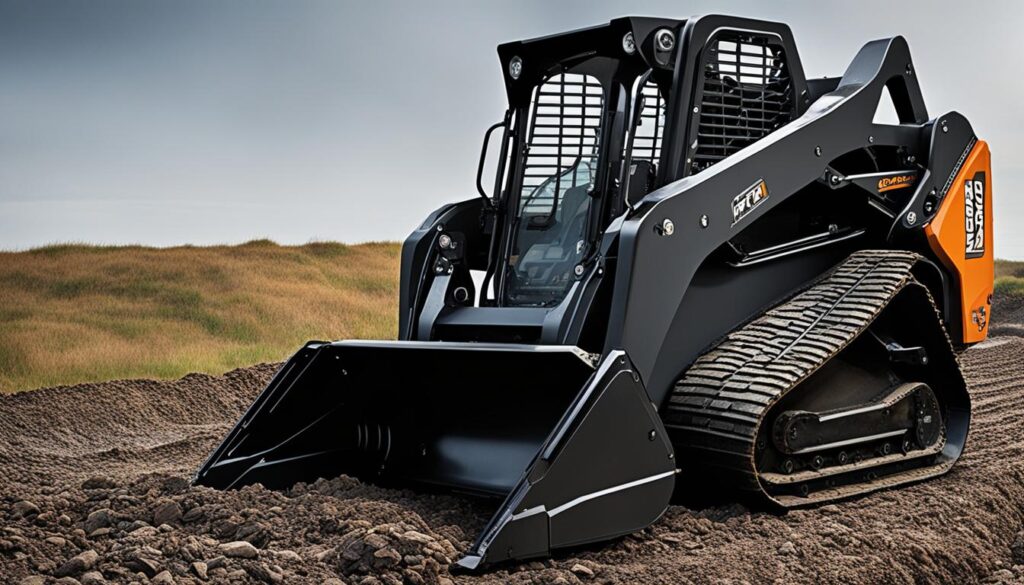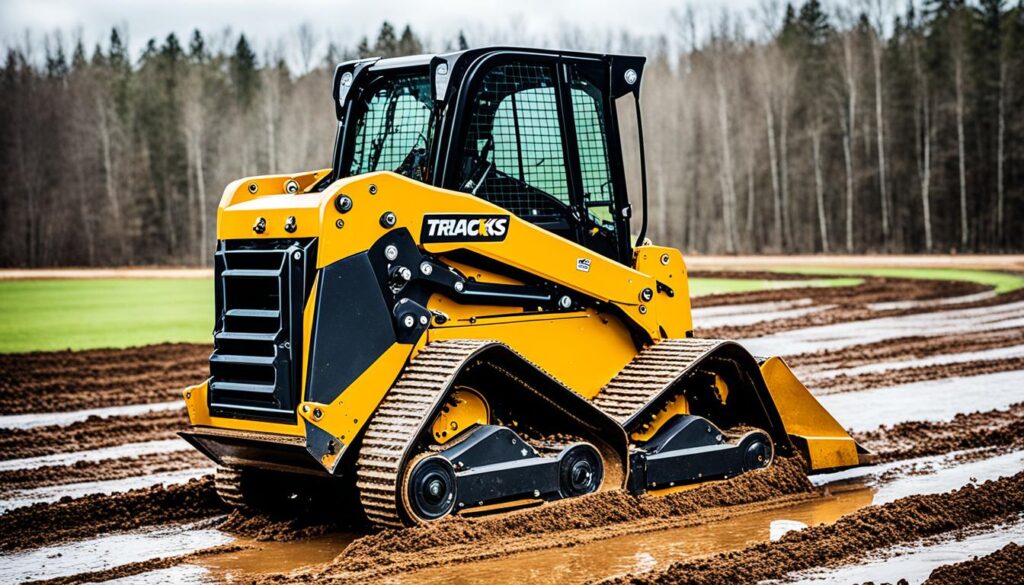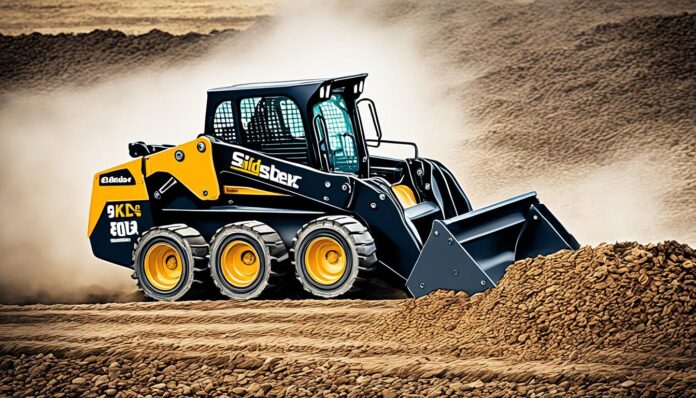As an Amazon Associate, I earn from qualifying purchases
When it comes to choosing between skid steer tracks and tires, making the right decision can significantly impact your job’s efficiency and productivity. Whether you’re working on challenging terrains or smooth surfaces, understanding the benefits and advantages of each option is crucial.
Wheeled skid steers, equipped with tires, offer several advantages. They are highly maneuverable, making it easier to navigate tight spaces and crowded job sites. Additionally, wheeled skid steers generally come at a lower cost, making them an attractive option for new skid steer owners. These machines perform exceptionally well on hard surfaces like concrete or asphalt.
On the other hand, skid steers with tracks provide superior traction and stability, making them the preferred choice for uneven terrains, slippery surfaces, and soft ground. With their increased footprint, track skid steers distribute the machine’s weight over a larger area, reducing the chances of sinking on soft ground. They excel in challenging applications such as snow removal or forestry work.
Another option to consider is the use of over the tire tracks. These specialized tracks can be added to wheeled skid steers, combining the benefits of both wheels and tracks. This configuration allows for enhanced maneuverability and traction when needed, making it a versatile choice for various job site conditions.
When deciding between skid steer tracks and tires, it’s essential to evaluate factors such as fuel efficiency, durability, cost, maintenance requirements, and performance in your specific operating conditions and job requirements.
Key Takeaways:
- Wheeled skid steers with tires offer maneuverability and perform well on hard surfaces.
- Skid steers with tracks provide superior traction and stability, making them suitable for challenging terrains and demanding applications.
- Over the tire tracks offer a compromise solution, combining the benefits of wheels and tracks.
- Fuel efficiency, durability, cost, maintenance, and performance should be considered when choosing between tracks and tires.
- The decision ultimately depends on your specific job requirements and operating conditions.
Advantages of Wheeled Skid Steers
When it comes to skid steer equipment, wheeled skid steers have a range of benefits that make them a popular choice among users. Let’s take a closer look at the advantages of using wheeled skid steers:
- Lower cost: One of the primary advantages of wheeled skid steers is their affordability. Solid tires, which are commonly used on wheeled skid steers, generally have a lower purchase price compared to tracks, making them a more cost-effective option for new skid steer owners.
- Suited for hard surfaces: Wheeled skid steers are better suited for working on concrete and asphalt surfaces. Unlike tracks, which tend to wear out quickly on these surfaces, solid tires provide optimal performance and longevity.
- Faster and more maneuverable: Wheeled skid steers are known for their agility and speed. These machines excel in applications that require quick movements and tight space navigation, making them an ideal choice for construction, landscaping, and other industries.
Overall, wheeled skid steers are most suitable for working on dry-level terrain and offer ease of maintenance. Their lower cost, compatibility with hard surfaces, and exceptional maneuverability make them a preferred option for many skid steer operators.
Customer Testimonial:
“I’ve been using wheeled skid steers for years, and they’ve never let me down. They’re fast, nimble, and perform exceptionally well on concrete surfaces. Plus, the lower cost of solid tires is definitely a bonus!” – Mark Anderson, Construction Contractor
Advantages of Skid Steers with Tracks
Skid steers with tracks have numerous benefits that make them an excellent option for challenging terrain and demanding work environments. These advantages can greatly enhance productivity and performance in various industries. Let’s explore some of the key advantages of skid steers equipped with tracks.
Enhanced Traction
One of the significant advantages of skid steers with tracks is their exceptional traction capability. The tracks provide increased grip on the ground, allowing the machine to maneuver efficiently on uneven surfaces and slippery terrains. This enhanced traction is particularly crucial in industries such as snow removal, forestry work, and construction sites with difficult terrain.
Better Floatation on Soft Ground
Skid steers with tracks offer superior floatation on soft ground due to their larger surface area. The weight of the machine is spread out, reducing the likelihood of sinking and ensuring stability even on muddy or marshy surfaces. This benefit is especially valuable in environments where the ground condition is unstable or prone to sinking.
Increased Stability and Safety
The larger footprint of skid steers with tracks provides enhanced stability, especially when operating heavy attachments on uneven ground. This increased stability minimizes the risk of tipping, ensuring a safer working environment. Skid steers with tracks are designed to handle challenging terrains and maintain stability even in demanding applications.
Reduced Soil Compaction
When operating on delicate grounds where soil compaction should be minimized, skid steers with tracks offer a distinct advantage. The distribution of machine weight over a larger area reduces the impact on the ground, minimizing soil compaction and preserving the integrity of the land. This benefit is particularly critical in industries where soil preservation is essential, such as landscaping or agricultural work.
| Advantages of Skid Steers with Tracks |
|---|
| Enhanced traction on challenging terrain |
| Better floatation on soft ground |
| Increased stability and safety |
| Reduced soil compaction |
Skid steers with tracks offer significant advantages that enable them to excel in rugged conditions and specialized applications. From superior traction to increased stability and reduced soil compaction, the benefits of skid steers with tracks are evident. Whether it’s working in forestry, construction, or industries with challenging terrains, tracks provide the necessary performance and reliability.

With a clear understanding of the advantages of skid steers with tracks, it becomes easier to determine whether they are the right choice for your specific needs.
Why Not Have Both? Over The Tire Tracks For Skid Steers
When it comes to choosing between wheeled skid steers and track skid steers, sometimes it feels like you’re stuck between two extremes. But what if there was a middle ground that combined the best of both worlds? That’s where over the tire tracks come in.
Over the tire tracks offer a compromise solution for skid steer owners who want the benefits of both wheels and tracks. These tracks can be added to wheeled machines, providing increased maneuverability and speed when needed, and improved traction and floatation when working in soft or wet conditions. By attaching the tracks over the existing tires, skid steer operators can enjoy the advantages of tracks without completely giving up the maneuverability of wheels.
There are two main types of over the tire tracks: rubber and steel. Rubber tracks provide the highest floatation and ground contact, making them suitable for urban contracting job sites where minimizing damage to the terrain is crucial. These tracks excel in providing traction on various surfaces, including mud, pavement, and gravel. On the other hand, steel tracks offer increased traction in slippery conditions, making them ideal for applications such as snow removal or working on icy surfaces. They are also known for their durability, withstanding the toughest job site conditions.
However, it’s important to ensure proper clearance before installing over the tire tracks. Depending on the make and model of your skid steer, you may need to use spacers to accommodate the tracks. This ensures proper alignment and prevents any interference between the tracks and the machine.
Whether you’re looking for enhanced traction, reduced ground disturbance, or improved performance in challenging conditions, over the tire tracks can be a valuable addition to your skid steer. They provide the versatility and flexibility necessary to tackle different job site requirements while maximizing productivity.
With over the tire tracks, you don’t have to choose between wheels and tracks. You can have the benefits of both and adapt to any terrain or job site conditions without compromising performance or maneuverability.
Considerations for Choosing Between Tracks and Tires
When deciding between skid steer tracks and tires, several factors should be carefully considered to ensure the right choice for your specific job requirements and operating conditions. Key considerations include fuel efficiency, durability, cost, maintenance, and performance.
Fuel Efficiency
Skid steer tires generally offer better fuel efficiency compared to tracks. The reduced rolling resistance of tires allows for smoother movement, resulting in potential fuel savings over long periods of operation.
Durability
Skid steer tracks are known for their exceptional durability, making them a reliable option for challenging terrains and demanding applications. Tracks can handle harsh conditions without excessive wear, ensuring longevity and reducing the need for frequent replacements.
Cost
When considering the cost, tires often have a lower upfront expense compared to tracks. However, it’s crucial to weigh the upfront investment against potential long-term maintenance and replacement costs. Tracks may have a higher initial cost, but they often provide better overall performance and durability in the long run, making them a cost-effective choice.
Maintenance
Maintenance requirements should also be taken into account. While tires generally require less maintenance, tracks may need more attention due to their complex design. However, tracks’ superior durability can result in fewer overall maintenance needs, offsetting the additional maintenance requirements.
Performance
When it comes to performance, each option has its strengths. Tires are more suitable for operations on smoother surfaces, providing excellent maneuverability. On the other hand, tracks excel in challenging terrains, delivering superior stability and traction. Assessing the specific needs of your job site and the type of terrain you frequently encounter will help determine which option offers optimal performance.
Ultimately, the choice between skid steer tracks and tires depends on various factors, including fuel efficiency, durability, cost, maintenance, and performance. It’s crucial to assess your specific requirements and operational conditions to make an informed decision that suits your needs best.
| Skid Steer Tracks | Skid Steer Tires | |
|---|---|---|
| Durability | Durable and resistant to wear in challenging terrains | May wear out quickly on rough terrains |
| Cost | Higher upfront cost, but lower long-term maintenance and replacement costs | Lower initial cost, potential for higher long-term maintenance and replacement costs |
| Maintenance | Require more maintenance due to complex design | Require less maintenance |
| Performance | Excellent traction and stability in challenging terrains | Great maneuverability on smoother surfaces |
| Fuel Efficiency | Slightly lower fuel efficiency | Better fuel efficiency |
Note: The table above provides a comparative overview of skid steer tracks and tires, highlighting key differences in durability, cost, maintenance, performance, and fuel efficiency.

Real-Life Experiences and Recommendations
Users who have tried both wheeled and tracked skid steers offer their insights and recommendations based on their experiences. Many users found that tracks performed better in challenging terrains and provided superior traction, especially in snow and muddy conditions. It was noted that wheeled skid steers were more suitable for smoother surfaces and situations where maneuverability was crucial. However, some users suggested using over the tire tracks as a compromise to enjoy the benefits of both options. Ultimately, the decision between tracks and tires depends on the specific job requirements and operating conditions.
User Testimonial
“I switched from a wheeled skid steer to a tracked skid steer, and the difference in performance is remarkable. The tracks provide excellent traction on uneven surfaces, making it easier to navigate through muddy job sites. I highly recommend tracks for anyone working in demanding terrains.”
– Jake Thompson, Construction Contractor
Recommended Skid Steer Track Brands
| Skid Steer Track Brand | Benefits | Price Range | Availability |
|---|---|---|---|
| Bobcat | Durable, excellent traction | $1,500 – $2,000 | Widely available |
| Caterpillar | High-quality, long-lasting | $2,000 – $3,000 | Authorized dealers |
| Camso | Wide range of sizes, good value | $1,200 – $2,500 | Specialty retailers |
Expert Tip
“If you’re undecided between tracks and tires, consider using over the tire tracks. They provide the benefits of both options, allowing for improved maneuverability on smooth surfaces with the ability to tackle challenging terrains when necessary.”
– Sarah Johnson, Skid Steer Operator
Conclusion
When it comes to choosing between skid steer tracks and tires, it’s important to carefully consider the advantages and disadvantages of each option. Wheeled skid steers offer exceptional maneuverability and cost-effectiveness, making them a great choice for smoother surfaces and projects with tight spaces. On the other hand, skid steer tracks provide superior traction, stability, and durability, making them the preferred option for challenging terrains and demanding applications.
Skid steer tracks offer excellent performance on soft ground, slippery surfaces, and uneven terrains, providing the necessary grip and stability to tackle even the toughest jobs. They are particularly beneficial for environments with difficult terrains where extra traction is required, such as forestry work and snow removal.
For those seeking a middle ground, over the tire tracks can be a suitable compromise. These tracks can be added to wheeled skid steers, providing increased maneuverability and traction when needed, while maintaining the cost-effectiveness and versatility of wheeled machines. This allows operators to enjoy the benefits of both wheels and tracks, adapting to different working conditions without the need for frequent equipment changes.
Ultimately, the choice between skid steer tracks and tires depends on the specific job requirements and operating conditions. Consider the terrain, the level of traction needed, and the durability requirements. By carefully evaluating these factors, you can select the option that best suits your needs and ensures optimal performance and productivity for your skid steer.
FAQ
What are the advantages of wheeled skid steers?
Wheeled skid steers are more maneuverable and cost-effective, making them suitable for smoother surfaces.
What are the advantages of skid steers with tracks?
Skid steers with tracks offer better traction, stability, and durability, making them ideal for challenging terrains and demanding applications.
Can you have both tracks and tires on a skid steer?
Yes, over the tire tracks provide a compromise solution that allows for increased maneuverability and traction when needed.
What should I consider when choosing between tracks and tires for my skid steer?
You should consider factors such as fuel efficiency, durability, cost, maintenance, and performance.
Are there any real-life experiences and recommendations regarding skid steer tracks and tires?
Yes, users who have tried both options offer their insights and recommendations based on their experiences.
